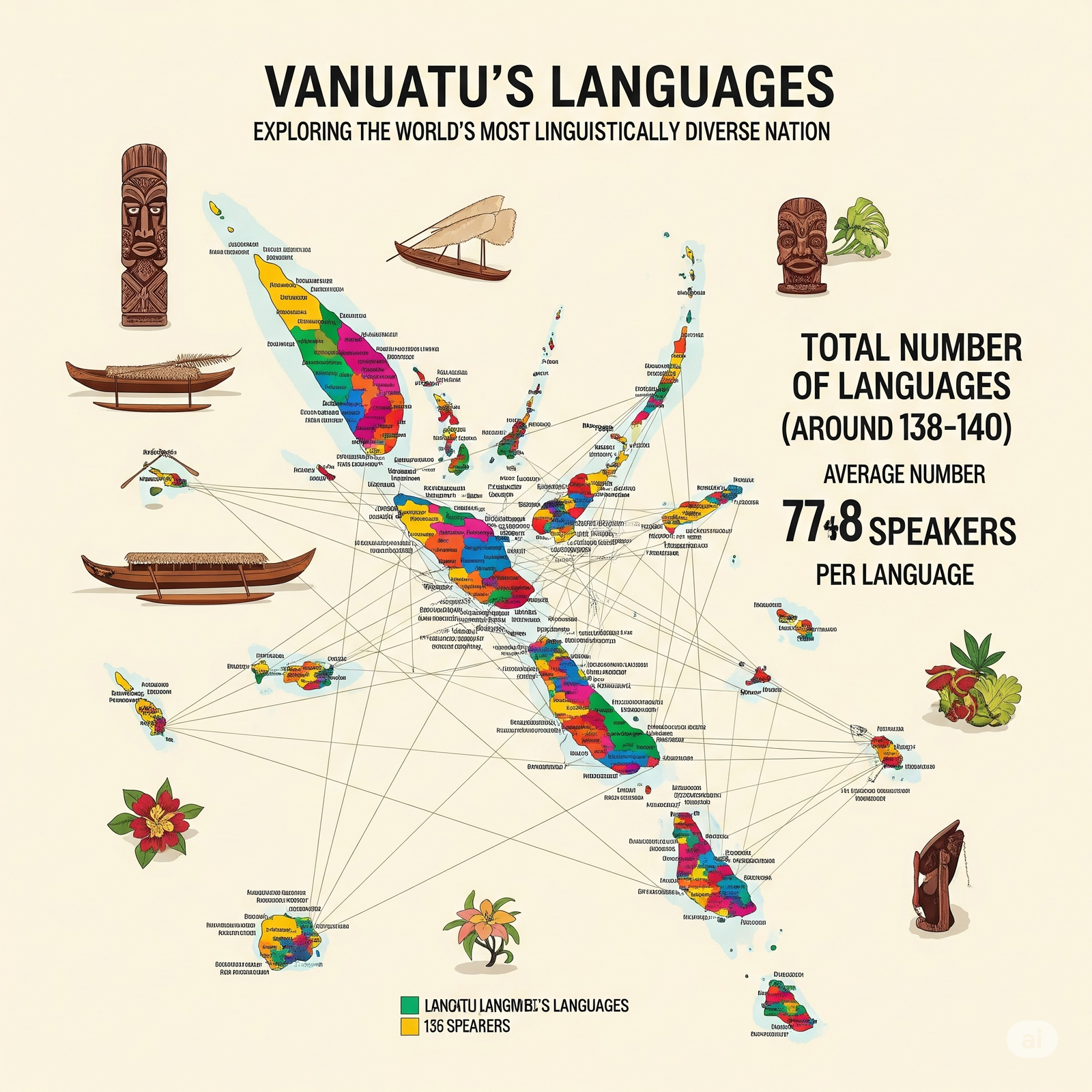Imagine a country roughly the size of Connecticut, home to just over 300,000 people, yet speaking more indigenous languages than almost any other nation on Earth. That country is Vanuatu, an archipelago in the South Pacific that proudly holds the title of the world’s most linguistically diverse nation per capita.
For anyone fascinated by culture, communication, and the sheer ingenuity of human expression, Vanuatu is a living linguistic laboratory.
The Astonishing Numbers: A Language for Every Village
Let’s put Vanuatu’s linguistic tapestry into perspective:
- It boasts over 130 indigenous languages, spoken across its approximately 80 islands.
- This means, on average, there’s roughly one language for every 2,300 people.
- Many of these languages are spoken by only a few hundred, or even just a few dozen, individuals, often confined to a single village or a small cluster of hamlets.
Compare this to vast nations like China or India, which have hundreds of languages but populations numbering in the billions. Vanuatu’s density of languages is truly unique.
Why So Many? Geography, History, and Kastom
Several factors have converged to create this linguistic phenomenon:
- Fragmented Geography: The archipelago’s numerous islands, separated by sometimes treacherous stretches of ocean, naturally led to isolated communities. Each community developed its own unique dialect, which, over centuries, evolved into distinct languages.
- Historical Migrations: Vanuatu was settled by multiple waves of Austronesian-speaking peoples over thousands of years, each bringing their own linguistic heritage.
- Kastom and Identity: Language is intimately tied to “Kastom” (traditional law and custom) and local identity in Vanuatu. Villages and tribes historically maintained their unique tongues as a marker of their distinct heritage and sovereignty. This strong cultural preservation instinct resisted widespread linguistic assimilation.
- Limited Colonial Influence (in some areas): While colonized, the pervasive influence of colonial powers didn’t uniformly homogenize languages as much as in some other regions, particularly in the more remote interior regions.
A Glimpse into the Languages
While impossible to list all 130+, these languages fall under the Oceanic branch of the Austronesian language family. They range from widely spoken ones (by Vanuatu standards) like Lenakel on Tanna or Tamambo on Malekula, to critically endangered tongues spoken by a handful of elders.
Each language is a treasure trove of local knowledge, oral histories, and unique worldviews, reflecting the specific environment and cultural practices of its speakers. For instance, languages might have highly specific terms for types of plants, fishing techniques, or volcanic activity relevant to their immediate surroundings.
Bislama: The Unifying Tongue
With such an astounding array of local languages, how do people from different islands communicate? The answer is Bislama, one of Vanuatu’s three official languages (alongside English and French).
Bislama is a Melanesian pidgin/creole language that emerged from interactions between ni-Vanuatu (the people of Vanuatu) and European traders, missionaries, and laborers. It’s based heavily on English vocabulary but with a distinct Melanesian grammatical structure.
- Role: Bislama serves as the crucial lingua franca, allowing people from different islands, who might not understand each other’s native tongues, to communicate effectively. It’s the language of markets, politics, and inter-island commerce.
- Ease of Learning: While unique, Bislama is relatively easy to pick up the basics for English speakers, making it a friendly entry point into Vanuatu’s linguistic world. Phrases like “Halo, yu stap olsem wanem?” (Hello, how are you?) quickly become familiar.
Preservation and Challenges
The sheer number of languages in Vanuatu also presents significant challenges. Many of these languages are critically endangered due to rural-to-urban migration, the dominance of Bislama in public life, and the influence of English and French in education.
However, there are ongoing efforts:
- Community-Led Initiatives: Many villages are actively working to teach their native languages to younger generations.
- Academic Research: Linguists are documenting and studying these languages, often in collaboration with local communities, to preserve them for future generations.
- Government Recognition: The very fact that Bislama, English, and French are official languages allows for a framework where diverse local languages can also be valued.
Experiencing the Diversity as a Visitor
For travelers to Vanuatu, the linguistic diversity is an enriching, albeit subtle, part of the experience:
- Listen Closely: On inter-island flights or at local markets, you’ll hear a fascinating cacophony of tongues.
- Learn Some Bislama: A few phrases of Bislama will go a long way in connecting with locals and showing respect.
- Engage with Guides: Local guides are often fluent in several local languages, English, and Bislama, and can offer incredible insights into the cultural significance of language.
- Visit Cultural Villages: Many cultural tours emphasize language as a core component of Kastom.
Vanuatu’s linguistic landscape is a testament to human resilience, cultural identity, and the fascinating ways in which societies develop. It’s a place where every island, almost every valley, holds a unique verbal key to its people’s history and soul. To truly experience Vanuatu is to appreciate the profound richness of its many voices.


Leave a Reply